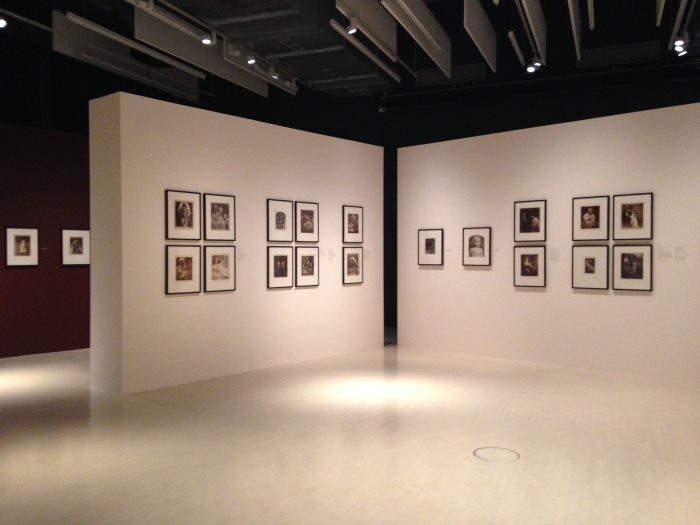
Julia Margaret Cameron: Influence and Intimacy at the Science Museum’s Media Space
London has been spoilt this past winter, although it probably didn’t realise. With 2015 marking the bicentenary of her birth, two of the South Kensington museums decided to pay homage to Victorian pioneer photographer Julia Margaret Cameron. The Victoria and Albert’s offering, which is now finished, centred on their impressive collection of Cameron’s works, splitting them thematically into family portraits, ‘Madonna’ groups and other allegorical works. The display at the Science Museum’s Media Space, subtitled ‘Influence and Intimacy’, draws on the Herschel Album, a selection Cameron compiled in 1864 of what she thought to be her best and most important works, and gifted to her friend and mentor Sir John Herschel. By 1975 it was considered so important to our understanding of early British photography that the government placed an export ban on it, saving it for the nation.
There’s something satisfyingly holistic about seeing the works as she compiled them; photographs of family and celebrity friends – eminent old Victorian men with impressive beards abound – are scattered in amongst allegorical works of women and children. In these latter pictures Cameron’s long suffering maidservant Mary Ann Hillier crops up again and again, by turns ethereally beautiful – as in “La Madonna Adolorata” –and then looking rather bored and resigned, as in “Teachings form the Elgin Marbles”, probably by now accustomed to long sitting times. Cameron’s niece and mother of Virginia Woolf, Julia Jackson, is an unearthly spirit flitting in and out of the room, appearing at different points on the wall, often in what seems to have been a signature pose with her head turned to one side, exposing a long neck, her plait catching the light ever so softly. In a notable exception, in what Cameron called “my favourite picture of all my works (my niece Julia)” – she looks straight through the camera, and almost it seems, into our very souls, with piercing light eyes and unbound, softly falling hair crowning her shoulders like some antique goddess or Pre-Raphaelite beauty.
The Antique past, Renaissance art and Britain’s own rich heritage of mythology and literature provided fertile subject matter for Cameron’s allegorical works: “Study of the Beatrice Cenci from May Prinsep” is possibly my favourite of all her works, taking inspiration from Renaissance artist Guido Reni to create a perfect illustration of melancholy. Her “St Agnes” – subject matter taken from an old English superstition that virgins dreamed of their future husbands on the Eve of St. Agnes, much used by the Romantic poets and Pre-Raphaelites – has a sculptural quality reminiscent of Michaelangelo’s Pieta, with the heavy drapery and downcast face casting strong shadows. However, what is really interesting about these works is the scratches, smudges, and other mistakes that are the mark of a photographer’s craft; not interested only in creating illusionistic perfect exposures, Cameron was a self-confessed amateur and we feel her fumbling her way through as she learns the medium; she left her processing mistakes there for us to see, defiantly incorporating them as experimental artistic features of her works, rather than trying to cover them up as embarrassing mistakes. In “The Dialogue” May Prinsep has evidently moved during the long exposure, creating a semi-transparency that gives her a ghostly presence, adding a new dimension to the photograph’s narrative; in a rare outdoor photography, “The Gardener’s Daughter” (to illustrate Tennyson’s poem of that same name), the girl is the only sharp point against a blurry background which appears like a swirling vortex, charging this scene of quietude with the weird other-worldly energy of nature.
I seem to remember this kind of art and photography being sneered at when I was at school – it’s not edgy or experimental to us, but has passed into the history and consigned to the term “sentimental”. However, a quick comparison with contemporaneous photography shows just how far she was transgressing the boundaries of accepted practice and taste, those terribly stiff poses against a twee painted backdrop contrasting with her dreamy blurred bodies and faces. What emerged from both the displays is a sense of woman of great determination, little modesty or sense of embarrassment that you might expect in her era, a woman who could twist men around her little finger to get her own way, despite being the ugly duckling amongst the seven beautiful Pattle sisters, and who used her enormous energy and affection to create some of the most moving and daring photographs of the 19th century.
Julia Margaret Cameron: Influence and Intimacy is on at the Science Museum until Easter Monday and is free of charge.
http://www.sciencemuseum.org.uk/visitmuseum/plan_your_visit/exhibitions/julia-margaret-cameron








